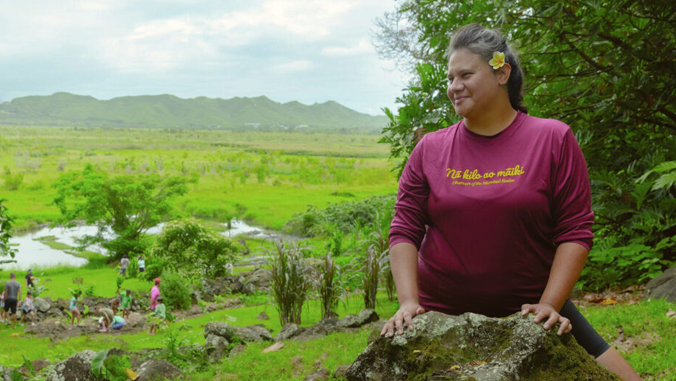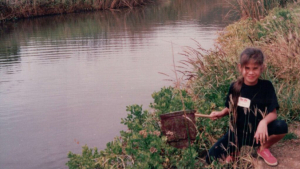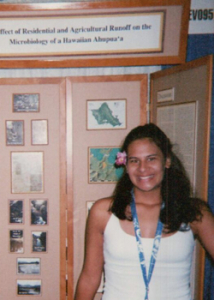
Some people become scientists. For Assistant Professor Kiana Frank of the Pacific Biosciences Research Center (PBRC) at the University of Hawaiʻi at Mānoa, it was evident early on in her childhood that she was born a scientist.

As an inquisitive 6-year-old growing up in Kailua, Frank listened to her great grandmother’s story about the lepo ʻai ʻia (edible mud) in the nearby Kawainui Marsh. According to the legend, the mud was eaten by King Kamehameha the Great’s warriors after the fierce Battle of Nuʻuanu, and Frank was told it to be similar in taste to her favorite food, paʻiʻai (pounded taro). However, there was a catch—to gather the mud, one had to maintain absolute silence.
While conducting her first silent expedition—eagerly tasting all the different colors and textures of mud in the marsh (that were not delicious)—she refined her kilo (observational skills), and developed a deep sense of ecological inquiry. While she did not find the magical mud, Frank discovered something more. Her calling as a scientist, and one who would later become one of Hawaiʻi’s leading experts in environmental microbes and their role in sustaining healthy ecosystems.
“I did not become a scientist, I was born a scientist because my kūpuna (ancestors) before me were natural scientists,” Frank said. “For me, science is how I connect to and better understand the places I love. Science is my tool to mālama ʻāina (protect, care for the land).”
One of these areas is Kawainui. Frank vividly recalls an old painting in her grandmother’s house that portrayed Kawainui not as the invasive marsh she was familiar with but as a loko iʻa (fishpond) that had once provided an abundance of food for all of Kailua. It was at that point, she began to ponder the impact of human activity on places like this. Frank delved into the foundational moʻolelo (stories) and mele (songs) of Kailua to gain insights into a healthy Kawainui ecosystem and its historical functioning.
“Our kupuna laid the groundwork with their scientific discoveries and passed on their knowledge to us in their moʻolelo,” said Frank. “It is our responsibility to learn from their observations and to continue to tell their stories.”
Discovering the world of microbes

As a freshman at Kamehameha Schools Kapālama, Frank discovered microorganisms. Microbes form the foundation of the food web, influencing the availability of nutrients and carbon for other organisms like algae, zooplankton and fish. Frank believed that understanding the role of microbes in the ecosystem was crucial to restoring the productivity back to loʻi (taro patch) and loko iʻa, as well as the key to finding the lepo ʻai in Kawainui.
She began to collect samples of microbes across Koʻolaupoko, investigating how land management influenced the diversity and distribution of microorganisms across ahupuaʻa (traditional unit of land management that runs from mountain to sea). She eventually developed a novel technique for DNA extraction from small volumes of water so she did not have to hike up and down mountains with gallons of water.
For her ingenuity and innovative work, she earned first place and best-in-category in environmental sciences at the 2004 Intel International Science and Engineering Fair in Portland, Oregon. After graduating, Frank earned a full merit scholarship to the University of Rochester where she studied molecular genetics and earned her bachelor of science degree magna cum laude in 2008. She continued on to Cambridge, Massachusetts to pursue research at the intersection of microbial ecology and biogeochemistry—earning her master of arts and PhD in molecular cell biology at Harvard University in 2010 and 2013, respectively.

When she returned home to the islands, her childhood dream of becoming a professor at UH Mānoa was realized. Today, Frank uses modern techniques in microbiology, molecular biology and geochemistry to complement and expand upon the observations of her kūpuna. With a unique blend of storytelling and scientific rigor, she brings to light the intricate workings of the world. From the tiniest microorganisms to the vastness of nature, Frank unravels mysteries of the unseen to deepen humankind’s understanding of and relationship to place.
“The deep held pilina (relationship) between ʻāina (the land), akua (natural elements, spiritual deities) and kānaka (the people) provided the foundation for ancient Hawaiʻi’s thriving abundance. Microbes are the physiological representations of this pilina,” said Frank. “Microbes are our akua, they are the unseen mediators of geochemical processes and ecosystem services that shape productivity ma uka i kai (from the mountain to the sea).”
For more about Frank’s work at PBRC, see Noelo’s 2023 cover story.
Noelo is UH’s research magazine from the Office of the Vice President for Research and Innovation.
- Related UH News story: Next generation of Native Hawaiian and Pacific Islander scientists shine, August 5, 2022

